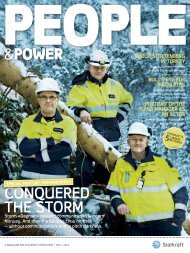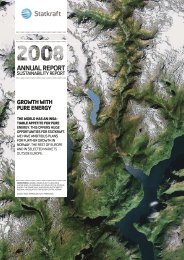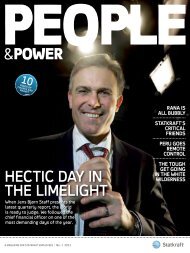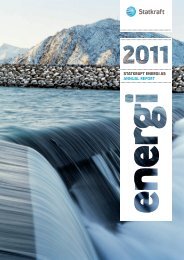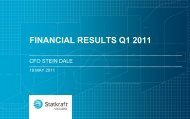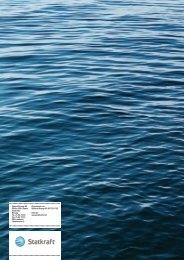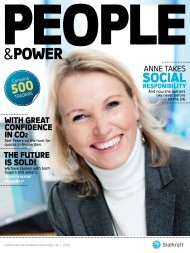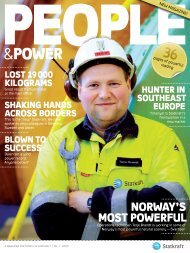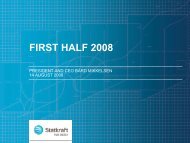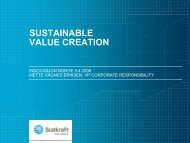Create successful ePaper yourself
Turn your PDF publications into a flip-book with our unique Google optimized e-Paper software.
HOT, HOT, HOT!<br />
Knapsack turns up the heat<br />
Six-page photo essay<br />
SN POwer:<br />
AUNexAmPle<br />
Climate certified comeback<br />
in the Philippines<br />
THePOwer OF GOOD<br />
COmmUNIC<strong>AT</strong>ION<br />
Bente E. Engesland has plans<br />
<strong>OUT</strong><strong>AT</strong><strong>SEA</strong><br />
Geir Asker is<strong>Statkraft</strong>’s first offshore worker<br />
Read more about offshore wind inour FE<strong>AT</strong>URE, pages 22-29<br />
A mAgAzine for you in stAtkrAft I no. 3 2011<br />
5<br />
spirited<br />
pages
eDitorial<br />
statkraft’sleading position<br />
Developments in the global energy markets<br />
in 2011 show that <strong>Statkraft</strong> has a very good<br />
starting point for delivering growth within pure<br />
energy.<br />
This spring, the UN Panel on Climate Change<br />
(IPCC) published its special report on renewable<br />
energy, which states that it will be possible to<br />
base 80 per cent of global energy consumption<br />
on renewable sources by 2050. The report stresses<br />
the unique position of hydropower as the<br />
cheapest and most efficient of all the renewable<br />
energy sources. Hydropower can also be stored<br />
and used to balance out non-flexible sources,<br />
and for irrigation in dry areas.<br />
Parts of the world are also changing their<br />
views on nuclear power as part of their energy<br />
supply. This is particularly true for Europe, where<br />
Germany has taken the lead with its decision<br />
to phase out all nuclear power by 2021. This<br />
means an increased need for renewable sources.<br />
In Norway, we have a specific goal to work<br />
towards, and that is to increase the renewable<br />
energy share of our total energy consumption<br />
2 StatKraft<br />
from 58 to 67.5 per cent by 2020.<br />
An importantframework condition forachieving<br />
this is thenew Swedish-Norwegiancertificates<br />
market,which should be in place in January.<br />
<strong>Statkraft</strong> has, through its owner, secured a<br />
significant capacity to fund new investments<br />
despite the unrest and uncertainty currently<br />
marring the financial and energy markets.<br />
<strong>Statkraft</strong> follows the business strategy plan we<br />
have prepared.<br />
Within the framework of the platform ”Deliver<br />
growth within pure energy,” we are looking for<br />
new opportunities to emerge in the wake of market<br />
developments.<br />
I am therefore confident<br />
that we, as Europe’s<br />
largest company within<br />
renewable energy, are in<br />
a leading position.<br />
christian rynning-<br />
tønnesen<br />
Presidentand CEO<br />
See more of the<br />
giant<br />
pages 14-19<br />
PHOTO dag spant<br />
ISSUe NO. 3, 2011<br />
Contents<br />
04 Back in business<br />
SN Power got the turbines going<br />
again inthe Philippines<br />
06 Windy Brits<br />
Maria McCaffery explains why<br />
07 Story of the spirit<br />
Three guys, one company, one book<br />
12 Local heating<br />
No longer icy towards district<br />
heating in Harstad<br />
14 600 000 litres per hour<br />
The Knapsack gas power plant requires<br />
alot of water –but few people<br />
20 Greek-Turkish milestone<br />
Turkey is connected tothe<br />
continental power system<br />
22 <strong>Statkraft</strong> on<br />
stranger tides<br />
Offshore wind power ahoy,<br />
but itisnot all smooth sailing<br />
30 Blame it on Rio<br />
The students with the coolest<br />
summer jobs<br />
32 Got Swahili?<br />
SN Power gets going in Africa<br />
34 Lilleaker’s very<br />
own powerhouse<br />
Meet Norway’s most energetic<br />
Head of Communications<br />
38 Great and small<br />
Lessons from minor incidents<br />
can prevent big ones.<br />
Editor in chief: Christer gilje<br />
christer.gilje@statkraft.com<br />
Editorial staff; Birger Baug, irene<br />
MacCallum, Lars Magnus günther,<br />
Kristian Løksa, Knut Fjerdingstad, Kathy<br />
Korte, Judith tranninger, gunilla Lundén<br />
Design and production:<br />
redink / www.redink.no<br />
Cover: geir asker, offshore worker Sheringham<br />
Shoal<br />
Cover photo: richard nunn<br />
Printed by: rK grafisk as<br />
Circulation: 5000<br />
Your tips and input are greatly<br />
appreciated. Send to: pp@statkraft.com<br />
PEoPlE & PowEr<br />
3
current events<br />
reopeneD after 12 years<br />
after being shutdown for more than 12 years due to an earthquake,<br />
the ambuklao power plant is finally back in operation.<br />
More than three years of intense rehabilitation work has yielded<br />
promising results for local conflict management, for the philippines<br />
as a nation and the Un.<br />
TexT Birger BaUg PHOTO sn power<br />
The rehabilitation<br />
has had apositive<br />
effect on the region.<br />
eriK Knive, evpisnpower soUtheastasia<br />
4 StatKraft<br />
SN Power’sAmbuklaoproject is<br />
an excellentexample forothers<br />
to follow according to theUN.<br />
SNPower and its local partner Aboitiz<br />
Power have finally succeeded in returning<br />
Ambuklao to the Filipino energy supply.<br />
It is expected that the facility will be fully<br />
operational by the end of 2011, and has<br />
met all budget and HSE expectations. The installed<br />
capacity of 105 MW will cover the energy needs of 1.7<br />
million Filipino households when the three turbines are<br />
producing at full capacity.<br />
stoppeD by earthquake In 2006, Aboitiz Power and<br />
SN Power formed the joint venture SN Aboitiz Power<br />
(SNAP), and since then, the company has grown to become<br />
one of the largest private generators of renewable<br />
energy in the Philippines. SNAP bought Ambuklao<br />
at an auction in 2007. The purpose of the state’s<br />
privatisation process of power facilities is to reduce the<br />
national debt and to secure the supply of energy. Experience<br />
thus far has shown that private players, through<br />
investments and sound operations, have increased the<br />
reliability of the power supply.<br />
The power plant in Ambuklao was completed in 1956,<br />
and is one of the oldest in the Philippines. In addition<br />
to generating power, the plant has played a vital role in<br />
preventing local floods. In 1990, the plant was severely<br />
impacted by an earthquake. After being partially operational,<br />
the plant had to shut down completely in 1999.<br />
exposeDtotyphoons The rehabilitation has been<br />
extensive. Before SNAP took over Ambuklao, several<br />
players had attempted to return the plant to an operational<br />
condition, but it was only when SN Power entered<br />
the picture, with its broad global experience and hydropower<br />
expertise, that they were successful.<br />
“Creativity and an ability to adjust to unpredictable<br />
conditions have been the secret behind the success in a<br />
demanding rehabilitation process,” says Erik Knive, executive<br />
vice president (EVP) in SN Power Southeast Asia.<br />
In both 2009 and 2010, powerful typhoons caused<br />
severe flooding and extensive damage to the plant. The<br />
solution included significant changes to the design of<br />
the tunnels. An alternate solution, developed by the<br />
project team, was quickly implemented within budget,<br />
despite a very high degree of complexity.<br />
approveD forcer The clean hydropower from<br />
Ambuklao replaces the consumption of coal, and will<br />
lead to a noticeable cut in Filipino greenhouse gas<br />
New head of SN Power<br />
SN POwer<br />
emissions. Ambuklao is, as is the SNAP owned power<br />
plant in Binga, certified as a CDM project under the<br />
Kyoto protocol. Clean Development Mechanism (CDM)<br />
provides industrial countries the opportunity to finance<br />
emission cutting projects in developing countries, and<br />
then have the reductions written off in their own emission<br />
accounts through transfer of Certified Emission<br />
Reductions (CER).<br />
In 2009, SN Power succeeded in having the UN approve<br />
the rehabilitation/upgrade projects in the CDM<br />
scheme. Ambuklao and Binga are the very first power<br />
plants to receive certification this way. The expanded understanding<br />
provides new opportunities to rehabilitate<br />
other, existing renewable energy power plants as well.<br />
employing 750 people "The Ambuklao project currently<br />
employs 750 people, and makes a significant contribution<br />
to both local employment and tax revenues,"<br />
says Knive. “In addition, more than 55 environment<br />
and corporate social responsibility projects have been<br />
implemented, including within economic development,<br />
health services and education. The rehabilitation has<br />
also had a positive effect on the region, particularly in<br />
regards to employment and local deliveries.”<br />
SNAP’s involvement also contributed to solving a<br />
long-lasting conflict between the local community and<br />
the previous owners of the power plant. The residents<br />
were displaced when the dam was built and the valley<br />
filled with water. They never received the promised<br />
assistance to rebuild their small community, and this<br />
soured the relationship between the residents and the<br />
Filipino state.<br />
The conflict is now resolved, and SNAP’s efforts have<br />
been noticed. Harvard University recently pointed to<br />
the case as an excellent example of a business case,<br />
and the UN refers to Ambuklao as best practice in<br />
terms of conflict resolution.<br />
“The formal opening of the rehabilitated power plant<br />
will take place on 26 October, hopefully with some VIPs<br />
among the guests,” says Knive.<br />
Creativity and an ability<br />
to adjust to unpredictable<br />
conditions have been the secret<br />
behind the success.<br />
eriK Knive, evpisnpower soUtheastasia<br />
torger lien has been appointed as the new CEO ofSNPower.<br />
Lien previously held the same position in Fred. Olsen Renewables AS.<br />
Lien has aMasters from NTNU inTrondheim, and broad experience from<br />
the energy sector. Hehas held anumber of positions inNorsk Hydro’s oil,<br />
gas and aluminium activities, aswell ashaving top positions inNorwegian Oil<br />
Trading AS, Pemco AS and Nord Pool AS.<br />
“I’ve really looked forward to starting in SN Power,” says Lien.<br />
“The company has achieved alot in its nine years, and has proven that it<br />
does have alicense on life. Ilook forward to developing it further.”<br />
Chairman of the SNPower board, Øistein Andresen, is very pleased<br />
to have Lien on board.<br />
“There were many qualified candidates, but I’m convinced Lien’s commercial<br />
background and broad knowledge of management and the energy sector<br />
will further strengthen SN Power’s growthinthe years ahead,” Andresen says.<br />
PEoPlE & PowEr 5
current events<br />
the environMentaL ForCe<br />
in each issue ofpeople&power various environmentalists present their view on the future’s energy solutions<br />
worLdLeaderinoFFshore wind power<br />
The UKisabout to take on aunique<br />
position in offshore wind power. Head of the<br />
industry organisation RenewableUK, maria<br />
mccaffery, comments onthe development.<br />
The UK is proud to be recognised as a<br />
worldleader in offshore wind power–<br />
arole that will grow considerably as<br />
more projects arerealised.The next<br />
round of offshoreprojects(known<br />
as Round3inthe UK)willcontribute another<br />
32 GW,increasing thetotal contribution from<br />
offshore wind powerto47GW–or more than<br />
one-thirdofBritish electricity consumption.Ina<br />
longer perspective,the totalcapacityfromwind<br />
energy generatorsanchoredonthe seabed is<br />
estimatedat116 GW in theUK. If all of this is<br />
developed,the UK couldbecomeanet exporter<br />
of electricity.<br />
RenewableUK represents thewindpowersector<br />
in theUK, andaimstoensurethat thesector<br />
continuesitstronggrowththrough contactwith<br />
theBritish authoritiesand other stakeholders.<br />
Theobjectiveistopromote thesector’s interestswithfact-basedstudies.<br />
Theindustryisfocussing on bringing down<br />
thecosts of offshore wind power, with atarget<br />
6 StatKraft<br />
of reducing costsbyone-third overthe next ten<br />
years. This is based on an expectation that the<br />
market is largeenough to promotecompetition<br />
andinnovation.Incooperation with theauthorities<br />
andother importantstakeholders, we are<br />
confident that we candeliver 20 GW by 2020,if<br />
we achieve theexpectedcostreductions.<br />
RenewableUK’s latest report “Offshore<br />
Wind –Forecasts of Future Costsand Benefits”<br />
examines themostimportant measurefor the<br />
offshore wind industry –lifecycle costsfor<br />
projects that will be developed between2011<br />
and2022. Theselifecycle costsinclude capital<br />
costs, operating costsand thepowerproduced<br />
in offshore wind farms.<br />
Assuming normal market conditions, it is<br />
expectedthat life cyclecosts foroffshore wind<br />
projects in theUKwillbereduced by more than<br />
15 percentinfixedpricesduringthe same<br />
period.If<br />
conditions<br />
arebetter<br />
than normal,<br />
costs<br />
couldbe<br />
reduced<br />
by 33 per<br />
Maria MCCaFFery, Ceo, renewaBLeUK<br />
cent.<br />
Capitalcosts associatedwithoffshorewind<br />
powerinthe UK,measuredper MW of installedcapacity,<br />
will continue to rise overthe next<br />
fewyears as projects will be developed further<br />
offshore andindeeperwaters.However, technologicaldevelopmentwillhavethe<br />
opposite effect,<br />
thus improvingthe cost scenario. Operating<br />
costsper installed MW will thus be significantly<br />
reducedfor wind farmsdeveloped during the<br />
course of thenextten years. Larger andmorereliable<br />
wind turbines arethe main reason forthis.<br />
Thereare anumber of examplesofhow the<br />
industry is rapidly developing in variousparts<br />
of theUK. TheSheringhamShoal wind farm,20<br />
km offthe coastofNorfolk,isscheduled to start<br />
full-scale production in 2012.Thisjoint venture<br />
between<strong>Statkraft</strong> andStatoilwillsaveahalf<br />
million tonnesofCO2 emissions peryear.<br />
Technologicaldevelopmentinthe international<br />
arena is continuing at breakneckpace. Just a<br />
fewmonths ago,RenewableUK welcomed the<br />
launch of a7MWwindturbine prototype from<br />
Vestas.“We see positive signalsfromgovernments<br />
around theworld,particularlyinthe UK.<br />
We expectthe bulk of offshorewinddevelopments<br />
will take place in NorthernEurope,”said<br />
Vestas Offshore’smanaging director Anders<br />
Søe-Jensenduringthe launch.<br />
After an intense campaign on behalf of the<br />
industry,weare pleased with thegovernment’s<br />
decision lastOctober to retain afundofGBP<br />
60 million forportupgrades. Projects in<br />
Round3are stimulating unparalleled grown<br />
we canall reap thebenefits<br />
of progress in therenewable<br />
energy sector<br />
80 meters<br />
Thenew Vestas wind turbines have awingspan equaltonineLondon double-decker buses.<br />
in thesupplier link,where companies such as<br />
Siemens,Gamesa, Doosan, Mitsubishi andGE<br />
have presentedplans calling forinvestments in<br />
production facilities in theUK, mainly forwind<br />
turbines.<br />
We canall reap thebenefitsofprogressin<br />
therenewableenergy sector.Our studiesshow<br />
that of the10800 full-timeequivalentsinUK<br />
wind power, wave powerand tidalpower, 29 per<br />
cent arewithinoffshore wind.In2021, atotal of<br />
90 000 people will work with offshore andlandbasedwindpower.<br />
We areproudtobeapartof<br />
this trend.<br />
“They tamed the water” is an attempt to put<br />
the soul of a company into words. an epic story<br />
of sacrifice and consummate skill.<br />
TexT Cato gJertsen PHOTO eriK thaLLaUg<br />
read about<br />
<strong>Statkraft</strong>'snew<br />
aChiEvEmEnt<br />
Pages 7-11<br />
the Water Whisperers<br />
PEoPlE & PowEr<br />
7
current affairs<br />
They tamed the water” is abrand new<br />
book about the development of hydropower<br />
inNorway. In this book weget<br />
the story directly from those who<br />
know more than anyone about building<br />
dams and blasting tunnels –the engineers.<br />
“Long before the dawn of the oil age, hydropower<br />
was Norway’s first gold,” says Trond Rostad.<br />
“And it was <strong>Statkraft</strong>’s engineers who brought<br />
these riches to the people with the aid of magnificent<br />
engineering and extremely dedicated<br />
work. In the book, the engineers tell the story<br />
in their own words, and I can promise there will<br />
be impressed gasps of admiration. Hydropower<br />
has not figured prominently in the telling of our<br />
nation’s history, but it gains its rightful place in<br />
the book.”<br />
excitingstories. The final book inthe series<br />
of three about <strong>Statkraft</strong>’s history was published<br />
in 2006. Noone can claim that the book did<br />
not address both major and minor incidents<br />
in the company’s history. However, there was<br />
something missing among the tales ofpolitical<br />
decisions and historic events –namely the<br />
stories about the crucial feats of engineering.<br />
By virtue of his position, Trond Rostad is<br />
concerned with ensuring that as many people<br />
as possible, both inside and outside <strong>Statkraft</strong>,<br />
develop aninterest inthe company and learn<br />
about its history. Therefore, he contacted<br />
historian Lars Thue (who was also amajor contributor<br />
to the three-volume set) in2009, and<br />
8 StatKraft<br />
Preparefor impressed<br />
gaspsofadmiration<br />
asked ifhewas interested intaking part in the<br />
new book project. Thue said yes, and they also<br />
recruited journalist Ivar Sekne to the team. The<br />
work took the form ofSekne interviewing many<br />
of the people mentioned in the book, Thue<br />
keeping track ofhistorical facts, while Rostad<br />
was <strong>Statkraft</strong>’s representative and managed<br />
relations and contact with the publishing house.<br />
According to Sekne, the project was originally<br />
slated to be 80-100 pages long. But there were<br />
so many good stories, and the educational illustrations<br />
were so interesting that the book ended<br />
up being a whopping 280 pages.<br />
Different challenges. “My goal has been to<br />
write soengagingly that the reader just can’t<br />
put the book down,” says Sekne. “The engineers<br />
Iinterviewed really opened upand shared<br />
many exciting stories about how they literally<br />
tamed the water. Some ofthe stories were fairly<br />
advanced and technical innature, but wehave<br />
consistently tried to simplify the language and<br />
context sothat everyone can get something out<br />
of the book.” Thue lends his support asSekne<br />
describes one of the main challenges faced in<br />
the work onthe book.<br />
“There were many discussions between the<br />
engineers and us,” says Sekne. "The disagreement<br />
largely revolved around the fact that they<br />
wanted more information to ensure the most<br />
precise text possible. For our part,wehad to<br />
guide the discourse so the content didn’t overshadow<br />
readability.”<br />
Can<strong>Statkraft</strong>’s soul be put into<br />
words? Ivar Sekne(left),Lars<br />
Thue (middle)and TrondRostad<br />
have tried.<br />
THE MEN BEHIND<br />
“THEY TAMED THE W<strong>AT</strong>ER”<br />
trond rostad: Currently senior adviser in<br />
statkraft (former director of information and<br />
public relations). project manager and liaison with<br />
the publisher, Universitetsforlaget.<br />
lars thue: historian employed byBi<br />
norwegian Business school. has written anumber<br />
of books and articles onhydropower innorway.<br />
recognised asone of the few living expertsonthis<br />
topic.<br />
ivar sekne: Journalist. interviewed many of<br />
the people mentioned inthe book. sekne has experience<br />
from the power sector, e.g. asinformation<br />
adviser inthe building and construction industry.<br />
Bytes control Watts<br />
“theytameD the Water” illustratesthe longstanding<br />
disconnect in status between Norwegian<br />
electrical engineers. Professors in high voltage<br />
subjectsatthe NorwegianInstitute of Technologycalled<br />
theschool’slow voltage programthe<br />
“flashlightprogram”,and thestudentsinthe high<br />
voltage programcalled theirlow voltage colleagues<br />
“the doorbell engineers”.While thesenicknames<br />
were usuallyaccompaniedbyasmile,therewas<br />
no disputing that thehighvoltage engineerswere<br />
thetop dogs. After all,they helpbuildand runthe<br />
Norwegianstate’s powerplants, whilethe low<br />
voltage engineersdid things likeconnect simple<br />
telephone lines betweenthe mighty powerplants.<br />
This picture changedstartinginthe late 1960s.<br />
Computer technologyand digitalisation of telecommunicationstechnology<br />
revolutionised low<br />
voltage disciplines andenergised theinformation<br />
society.From1967, Tokkepowerplant,and<br />
graduallyalso thesix other powerstationsinthe<br />
Tokkecomplex,wereremote-controlled from a<br />
dedicatedoperationscentre. An extensive signal<br />
networktransmitted information on thestatus<br />
of thepowerplantstothe operationscentre, and<br />
transported“commandsignals”fromthe operationscentretothe<br />
variousparts of thesystem.<br />
Thesetypesofpowerplant groups runfromthe<br />
same operationscentre, becamecommonplace<br />
throughout<strong>Statkraft</strong>.<br />
Today, all of <strong>Statkraft</strong>’spowerstationscan in principlebeoperatedfromthe<br />
company’sheadoffice<br />
at LilleakerinOslo.Runningthe powerstationsis<br />
based on complexcomputer modelsofthe power<br />
market.Bytes nowcontrolproduction of watts…<br />
The perfect gift?<br />
“they tameD the Water” has alarge<br />
audience. The list includes <strong>Statkraft</strong>’s own<br />
employees, external partners, subcontractors<br />
and private individuals who are interested in<br />
this unique slice ofNorwegian history. So far,<br />
2000 books have been printed and they make<br />
afine gift in connection with business promotions,<br />
anniversaries orother special events, or<br />
as atoken of appreciation. To order your copies<br />
contact Trond Rostad at (+47) 24067164or<br />
email trond.rostad@statkraft.com.<br />
strong LangUage<br />
PAGE 94 of thebookcontains aquote from<br />
thestorywritten by Sofus(surnameunknown),<br />
most likelyareporter in “Fossekallen”(People<br />
&Power’spredecessor). In 1954, Sofusfilesa<br />
report from thetunnel blasting work in connection<br />
with construction of Røssågapowerplant in<br />
Nordland County.The language wasdefinitelyof<br />
the“flowery”variety…<br />
“The weepeople hadthe mountains to<br />
themselves.Thiswas no place fordeepconversations;<br />
here it wasall aboutmovingthe mountain.<br />
Withoutthe ponderousdumptors, it wouldindeed<br />
beenslowgoing.Theyworkedlikehuge, hungry<br />
trolls.Therewere63ofthem at Røssåga.”<br />
“Slowly, andnodoubt with excruciating pain,<br />
THe w<strong>AT</strong>er wHISPererS<br />
Valves at Nedre Røssåga.<br />
read the<br />
story behind<br />
Europe's most<br />
awESomE<br />
stonebystonewas ripped from themountainas<br />
thecold metalbitspunched deeper anddeeper<br />
inward,while thedynamite finishedthe job…..<br />
It waslikeopening theirondoortothe gatesof<br />
hell.Thiswas realityatits most unreal, where the<br />
screamingdecibelscould very nearly wrestthe<br />
stones from theirhazynests.The huge boring<br />
platform growledand roared.The men moved<br />
slowlyand with determination –inward, ever<br />
inward,shakentothe core. Accompanied by<br />
sometimesinscrutable signsofthe foreman, here<br />
thedeafhad theirown alphabet. Thetraditional<br />
old navvysongs couldneverhavebeenbornhere.<br />
Perhaps ayoung mancould sing “Rockaround<br />
theclock”–but wouldanyonehear?<br />
PEoPlE & PowEr<br />
9
current affairs<br />
Size does matter.Hereisthe<br />
end pieceofthe 140-metredrill<br />
“Støldalsgubben.”<br />
The mother of all Ferraris<br />
vroooom! Ulla-Førre in Rogaland County is<br />
still like agiant Ferrari among Norwegian power<br />
plants. The story behind this record-breaking<br />
plant can befound in the pages of“They tamed<br />
the water.”<br />
Almost everything went right for the <strong>Statkraft</strong><br />
power plants when the Ulla-Førre river system<br />
was developed. The power plant in Kvilldal was<br />
opened by King Olav Vin1982, the first time<br />
the King had ever opened apower plant. The<br />
Ulla-Førre development was planned and built<br />
during atime ofgrowing skepticism against<br />
hydropower development, but the opposition<br />
never really reached Ulla-Førre and the river<br />
system was not covered under the 1972 conservation<br />
plan.<br />
10 StatKraft<br />
aDvanceD technology From time immemorial,<br />
Western Norway has been where cold<br />
air from the northmeets with warm air from the<br />
south. This has created the unfailing stream<br />
of low pressure centres that lets the rain pour<br />
down, turning Western Norway into the European<br />
gold medalist for precipitation. The Ulla<br />
and Førre rivers inSuldal have solid sources,<br />
but plans for exploiting this wet wealth did not<br />
surface until the beginning of the last century.<br />
In 1911, aneloquent farmer begged the state<br />
to do something concrete to save Suldal from<br />
decline. “Buy the mighty water, bring us money,<br />
let the country bebuilt!”<br />
We don’t know whether it was the farmer’s<br />
plea that tipped the scales, but the state did<br />
buy the waterfall rights for NOK 600 000 in<br />
1912. However, nothing really happened until<br />
the 1970s, when prosperity and consumption<br />
skyrocketed. Planning started in1971,<br />
including arevolutionary (at the time) computerbased<br />
pressure support program developed at<br />
NTH. Engineering of the record-breaking Blåsjø<br />
reservoir, an ingenious system of 11 large and<br />
small dams, was also aplum for the detailed<br />
engineering office. Four power plants were tobe<br />
built, with construction led bythe enthusiastic<br />
engineer Jacob Kielland.<br />
140-metre Drill The Norwegian state’s first<br />
attempt atfull-face boring of tunnels took place<br />
in 1981. This successful attempt took place at<br />
europe’smost<br />
wicked power<br />
plant–byexperts<br />
called agiant Ferrari.<br />
the the Ulla-Førre plant, although it took the<br />
140-metre long “Stølsdalsgubben” nearly two<br />
years tobore out eight kilometres of tunnel<br />
with adiameter of 3.5 metres.<br />
Atechnological baptism byfire came in<br />
1986 with three tunnels drilled in deep water<br />
in the Blåsjø reservoir. The three blasts were<br />
set off simultaneously, causing the air to<br />
shimmer. Anenormous water column proved<br />
that the triple blast was successful!<br />
nok 2.7 million hq Many records were set<br />
at Ulla-Førre during this period. The Blåsjø<br />
reservoir isNorway’s largest hydropower<br />
reservoir. The Storevass dam is Norway’s<br />
largest dam with abituminous concrete core.<br />
The Førrevass dam became Norway’s largest<br />
concrete dam and the Oddatjørn dam is<br />
Norway’s tallest rock-fill dam –at140 metres<br />
tall. All of these are engineering feats. Never<br />
before had such long tunnels with such large<br />
cross-sections been built.<br />
In 1986, thelastunits at Kvilldalstarted operation.Evensince,Europe’smostwickedpower<br />
plant –called by expertsagiant Ferrariwith<br />
its2.7 million horsepower, 20 small andlarge<br />
dams and125 kilometres of tunnels–has<br />
delivered asteady, reliable supplyofpower.<br />
THe w<strong>AT</strong>er wHISPererS<br />
Knut OveHillestad,<br />
photographed in 1961,<br />
reprintedfrom“They<br />
tamedthe water.”<br />
when statKraFt<br />
went green<br />
knut ove hillestaD (1924-2005) isthe man<br />
who personifies the watershed divide when <strong>Statkraft</strong><br />
started tolisten to the outside world when building<br />
power plants.<br />
Themajor powerplant developments rightafter World<br />
WarIIwerenot particularlygentle, causingsignificant<br />
impactonthe naturallandscape.Duringthe 1950s,an<br />
increasing number of people called foragentler,better<br />
approach.Inthe early1960s,natural andenvironmentalorganisationsgainedgreater<br />
credenceinthe social<br />
debate,and theNorwegian Water Resourcesand Energy<br />
Directorate(NVE) and<strong>Statkraft</strong> establishedthe Officefor<br />
LandscapeProtection andNatureConservation in 1963.<br />
Knut OveHillestadwas in charge of theoffice,anactive<br />
manwho didnot mincewords. He believedthat the<br />
rock tips anddamswerelikeenormous“grey deserts”<br />
Hispersonalinvolvement<br />
wascrucial in changing<br />
thecompany’s attitude.<br />
in thelandscape,and that moreconsideration hadto<br />
be giventoprotectingand preserving thenatural landscape.When<br />
Hillestad’sideas graduallygainedsupport,<br />
this is duetoincreasingpressureonthe powersector<br />
from outside,but hisown personalinvolvement wasalso<br />
crucialinchangingthe company’sattitude.<br />
Protests anddemonstrationsagainst thepower<br />
developments grew throughoutthe 1960sand 1970s.<br />
<strong>Statkraft</strong>’smajor developmentplans graduallybecame<br />
thesubject of huge discussionsthat increasingly ledto<br />
areduced scope. This pressure caused thedeveloper<br />
to give more consideration to theenvironment.Atthe<br />
same time,natureand environmentalconservation also<br />
trulyentered thelegislative arena, andgained theirown<br />
officialinstitutionsamong thegovernment agencies.<br />
This includedestablishment of theMinistryofthe<br />
Environmentin1972.<br />
At thesametimetherewas an institutionalisation<br />
of thenatureand environmentalprotection mindsetin<br />
<strong>Statkraft</strong>, with Hillestadmakingamajor contribution.<br />
Through cooperation with biologistsand other expert<br />
groups,Hillestad’sworkwas aboutmuchmorethanaesthetics.Asill<br />
projectstarted in the1970s contributedto<br />
atype of sill that protected salmon andtroutpopulations<br />
in developed watercourses,abenefit still enjoyedby<br />
today’sanglers.Today,green values areincorporated<br />
as part of thetechnicalplans forevery development.<br />
Thestudy processhas beenformalised andbothlocal<br />
stakeholders andenvironmentalinterests areinvolved<br />
to asignificantdegree.<br />
PEoPlE & PowEr<br />
11
current affairs<br />
Hjellholmen by night: Well-designed lighting will<br />
contribute to making the district heating plant a<br />
landmark (illustration/photo: Vizuell)<br />
HAPPy<br />
TOwN<br />
Following protests against streets being dug up<br />
and uncertainty about air quality, things have calmed<br />
down in harstad. now, the mayor, employees and<br />
residents look forward to the district heating plant<br />
opening early next year.<br />
12 StatKraft<br />
we were perhaps somewhat taken<br />
aback by the information need, at<br />
the same time as we had unnecessarily<br />
long digging periods due to<br />
delivery problems,” admits site manager Stig<br />
Haram of Hinnstein AS.<br />
insatiable neeD Kristin Myreng Grimstad of<br />
Kunnskapsparken Nord, who works with value<br />
creation within renewable energy and has been<br />
one of the key supporters of the new district<br />
heating plant, agrees.<br />
“I think you could say that in the beginning,<br />
Trondheim Energi/<strong>Statkraft</strong> did not understand<br />
that the information need is almost insatiable,”<br />
she says. “The company came from Trondheim,<br />
where they’ve had district heating for decades,<br />
and where everyone is familiar with this form of<br />
energy.”<br />
great aDvantages After the information<br />
efforts were intensified, including printing a<br />
magazine for the residents, the debate calmed<br />
down. This also means that it is possible to get<br />
across the advantages of the district heating<br />
plant being constructed at Hjellholmen. Some<br />
of those advantages are the creation of many<br />
new jobs, both directly and indirectly; that it will<br />
pollute less than the current solutions; and, not<br />
least, that it will increase logging in the regional<br />
forests. <strong>Statkraft</strong> has entered into an agreement<br />
with local company Nord Norsk Bioenergi for<br />
supply of wood chips for 10 years. The company<br />
will collect the raw materials from the southern<br />
parts of Troms County and the northern parts<br />
of Nordland County, which means that forests<br />
that are currently mostly unused, will create new<br />
value for the owners.<br />
Theheating plant at theHjellholmen facility will<br />
also become anew landmark.The exteriorisvery<br />
pleasing,atleast if you appreciate alittleindustrial<br />
aesthetics,withfacades in coloured glass, metallic<br />
coloursand awell-designedlighting scheme during<br />
theArcticwinter.The largestbuilding, thewood<br />
chip storage, will be 17 metres high,while the<br />
smoke stack will reach 40 metres.<br />
operations manager is confiDent <strong>Statkraft</strong><br />
Varme’s recently hired operations manager<br />
at Hjellholmen, Leif B. Pedersen, has followed<br />
the debate closely, and is not frightened by the<br />
strong language.<br />
“Nah,it’sgreat that people getinvolvedinprotection<br />
thelocal environment, buttimewillindeed<br />
show that this is agood facility that pollutesless<br />
than thealternatives,” he says.<br />
“After visiting many facilities here in Harstad, I'm<br />
In Trondheim they actually had a<br />
torch-lit procession against district<br />
heating in the 1990s, but now, customers<br />
beg for the license areas to be expanded.<br />
LeiF B. pedersen, operations Manager<br />
Kristin Myreng Grimstad of Kunnskapsparken Nord<br />
has been a key supporter of the district heating plant.<br />
confident in saying that district heating will be an<br />
enrichmentfor thetowninterms of theenvironment.<br />
Many of theold oilfurnacesare readyfor<br />
replacement, butwerenevertheless puttouse<br />
againlastwinter duetothe high electricity prices,”<br />
says Pedersen, pointing to thegood resultsin<br />
Trondheim.<br />
“Theretheyactuallyhad atorch-lit procession<br />
DISTrICT He<strong>AT</strong>ING<br />
Large excavations infuriated<br />
residents in Harstad<br />
Mayor Helge Eriksen is happy that the most intense<br />
digging period is over, and looks forward to the first<br />
quarter of 2012.<br />
againstdistrictheating in the1990s,but now,<br />
customersbeg forthe licenseareas to be expanded,”hesays.<br />
“Boththe industrial andprivate<br />
marketsinthe Trøndelagcountieshavehad very<br />
expensiveelectricity in recent years.”<br />
He also points outthe addedvaluefor themunicipality,through<br />
localacquisition of wood chips,<br />
transportofwood chips, electricaland plumbing<br />
services andsnowploughing,tonameafew<br />
examples.<br />
harstaD neeDs more Digging Harstad<br />
mayor Helge Eriksen is also pleased with both<br />
the digging and the information.<br />
“Atthe beginning, it took toolongbetween the<br />
ditchesbeing opened andclosed,but therehave<br />
beenimprovements,” he says.“At thesametimeit<br />
is importanttostressthat digging is an expression<br />
of activity,developmentand newinvestments.<br />
Harstadneeds more digging andmorecranes.”<br />
Themayor also appreciatesthe “good continuing<br />
cooperation”with<strong>Statkraft</strong> Varme.<br />
And the air quality?<br />
“I don’t worryabout that.The licensestipulates<br />
strict requirements forair quality, andair quality<br />
measurementswillbecarried out,”saysEriksen,<br />
who looksforward to theplant opening in thefirst<br />
quarter of 2012.<br />
PEoPlE & PowEr<br />
13
photo essay<br />
theefficient<br />
giant<br />
very few gaspower plants areasefficientasKnapsack 1.<br />
from 2013,whenKnapsack 2comes online,<strong>Statkraft</strong>’s german<br />
giants cansupplyone million people with power.<br />
PHOTO dag spant TexT Cato gJertsen<br />
14 StatKraft<br />
kNAPSACk<br />
PEoPlE & PowEr<br />
15
PHOTO eSSAy<br />
SOLID PL<strong>AT</strong>ES.Smackbetween theoffices (tothe left<br />
in thephoto)and theheatingand ventilation hall (onthe<br />
right),smallmetal warts dotthe roadway. They arespeed<br />
bumps, whichare commonplaceinthe Colognearea;<br />
hencethe nickname “Cologneplates.”<br />
TAKING ABRE<strong>AT</strong>HER. AlexandraKunkel in HR recentlycelebrated<br />
her birthday andtreated her colleaguestoastrawberry<br />
cake.Shift leader DennisBischoff(left) andoperatorOlafJacob<br />
enjoying some cake in thecontrol room.<br />
16 StatKraft<br />
kNAPSACk<br />
GINORMOUS. Smoke stack no. 2from<br />
the gas turbine towers 55metres above<br />
the ground. Photo taken from the roof<br />
of the cooling tower.<br />
PEoPlE & PowEr<br />
17
PHOTO eSSAy<br />
CONTROL FREAK. This “redhead”isusedtocheck<br />
whether thefilter is contaminated. Thefilter must<br />
be replacedassoonasthe pressuredifference<br />
betweenthe twomanometersistoo high.<br />
18 StatKraft<br />
The <strong>Statkraft</strong> culture creates a good, pleasant<br />
atmosphere, which makes us want to make that<br />
additional effort when needed.<br />
KLaUs sUMMer, headoFKnapsaCK<br />
With anannualproduction of 800<br />
MW,Knapsack1is<strong>Statkraft</strong>’s<br />
largestgas powerplant in<br />
Germany. In twoyears,Knapsack<br />
2willbecomplete,bringingtotal<br />
output to awhopping 1230 MW.<br />
16 January 2008 was the first day of commercial<br />
power production for <strong>Statkraft</strong> in Knapsack,<br />
located just outside Cologne. In the beginning,<br />
the power plant also supplied power to a major<br />
customer in The Netherlands. Production planning<br />
and sales have otherwise always been<br />
managed by the trade department in Düsseldorf.<br />
Power plant manager Klaus Summer explains<br />
that the ultra-modern plant consists of two gas<br />
turbines, each with an output of 270 MW, and a<br />
steam turbine with an output of 260 MW.<br />
THE BOSS HIMSELF. Klaus Summer has worked as plant manager at Knapsack since<br />
April 2009. “It was easy to accept the job,” says Summer.” <strong>Statkraft</strong> has a relaxed and<br />
inclusive culture which, in a way, is a bit different from the “typical German.”<br />
58 PER CENT “Older gas power plants have an<br />
efficiency rate of 42 to 45 per cent, approximately<br />
the same as for coal power plants,” says<br />
Summer. “Due to the modern technology applied<br />
at Knapsack 1, the power plant’s efficiency is an<br />
impressive 58 per cent.”<br />
Summer and his 32 colleagues are very proud<br />
of their jobs. All employees must possess keen<br />
technical insight. Painstaking work is required<br />
to start and stop the power plant at the correct<br />
times, and to deliver the exact volumes of power<br />
required from minute to minute.<br />
“Italso meansalot to work for<strong>Statkraft</strong> and<br />
thecompany’s very prominentgreen image,”<br />
kNAPSACk<br />
says Summer.“Andtotop it all offisthe <strong>Statkraft</strong><br />
culture. Thereare alot of positive thingstosay<br />
aboutthe cultureand,asfor myself,Iparticularly<br />
valuethe mutual trustand confidenceshown<br />
by everyone. This createsagood,pleasant<br />
atmosphere that encouragesustowanttomake<br />
that additionaleffortwhen needed.”<br />
An extraeffortmay be very welcomewhen Knapsack<br />
2startscommercialoperation in thesummer<br />
of 2013.The decision came as aresultofthe marketdevelopmentforecastin2008,<br />
andthe ground<br />
work is already underway. Thenew gaspower<br />
plant will produce430 MW,and will also mean an<br />
increase in thenumber of <strong>Statkraft</strong>employees.<br />
Knapsack 1 and 2 will then be able to supply<br />
about 1 million people with power.<br />
WET. Communication adviser Judith Tranninger isproud of Knapsack’s impressive<br />
size. Here she is pictured inside the enormous cooling plant where 600 000 litres of<br />
water pass through every hour. The closed system holds atotal of 37 million litres of<br />
water. Three lifebuoys have been strategically placed inthe facility to help prevent<br />
drowning incidents.<br />
PEoPlE & PowEr 19
current event<br />
Turkishpower is nowtraded<br />
in other countries.<br />
20 StatKraft<br />
Cross-border agreement<br />
statkraft has entereD into its first cross-border agreement with<br />
Turkey and Greece. The company bought 10 MW capacity from a Turkish<br />
company, which brought the power to the Greek-Turkish border, and from<br />
there it was sold on the Greek power exchange.<br />
The Turkish power system was synchronised with the central European<br />
system on 18 September last year, and is currently in a test period.<br />
“The agreement is a milestone for cross-border power trading in this<br />
region,” says head of new markets, Claus Urbanke. “We hope that the power<br />
exchange will increase in the future, because we see a great potential in<br />
Turkey and the surrounding markets.”<br />
Ateamsuccess: Well done of theNepali team reaching the<br />
second roundofplayoffsintheirfirstNorwayCup appearance.<br />
Nepali success in Norway Cup<br />
statkraft sponsoreD a team from Kirne, Nepal in this year’s Norway Cup.<br />
SN Power is one of the co-owners of Himal Power Ltd. This year, we sponsored a 14-yearold<br />
girl’s team who got the opportunity to play against teams from other countries at the<br />
soccer fields at Ekeberg in Oslo. They lost their first match 3 to 1, but won the following<br />
matches 6-0 and 1-0, which brought them to the playoffs in their debut cup appearance!<br />
The success continued in the initial playoff game, with a 1-0 victory over Åndalsnes,<br />
before Lom defeated them 0-3 in the following game.<br />
<strong>Statkraft</strong>’s Ingebjørn Nygård and Leif Harald Hansen – former power plant manager and<br />
maintenance manager of Khimiti respectively – served as the Norwegian team managers<br />
for Kirne. The head office were also treated to a touch of Nepal as the entire team<br />
was invited for lunch. On the menu? A Nepali dish called Daal Bhaat.<br />
turkish<br />
powerhas a<br />
go in greece<br />
…And forever after<br />
Fined by NordPool<br />
Spot and NASDAQ<br />
OMX<br />
STaTkRafT ENERgi aS hasbeen<br />
issued afine totalling NOK 400000<br />
by NordPool Spot AS andNADAQ<br />
OMXOslo ASAfor violatingthe power<br />
exchange’s trading regulationsin<br />
connection with an erroneousreport<br />
to thephysical powermarketand associated<br />
trades in thefinancial power<br />
market on 27 October 2010.<br />
Reportingand controlroutineshave<br />
beenthoroughly reviewed since, and<br />
procedures have beenupdated.<br />
Both thefoundation stone andthe rest<br />
of Cheveswill have greatsignificance<br />
forPeru.<br />
Party on in Cheves<br />
at the onset of summer the<br />
foundation stone was laid for<br />
the construction of the Cheves<br />
power plant in Peru. The event was<br />
organised by SN Power and agreat<br />
feast marked the occasion. Cheves<br />
will have acapacity of168 MW, and<br />
can generate asmuch as837 GWh<br />
annually when completed in2013.<br />
It is estimated that the power plant<br />
will reduce Peru’s CO2 emissions by<br />
394 000 tonnes annually.<br />
<strong>Statkraft</strong> Energi AS and Sjøfossen Energi AS have entered into an agreement which secures<br />
eternal ownership ofSjøfossen power plant for the latter.<br />
The local power company in Nordland County has leased the waterfall rights at Sjøfossen<br />
power plant from <strong>Statkraft</strong> since 1947. The lease runs out in 2018 and <strong>Statkraft</strong> then has<br />
the right to reclaim the facility at technical value. The two companies have now entered into<br />
an agreement under which <strong>Statkraft</strong>,after reclaiming, will sell the facility back to Sjøfossen<br />
Energi, including the waterfall rights.<br />
“We’re very pleased in securing continued ownership ofone of our most important power<br />
plants for eternity,” says managing director of Sjøfossen Energy,Steinar Pettersen.<br />
“This isagood commercial agreement for both <strong>Statkraft</strong> and Sjøfossen Energi,” says <strong>Statkraft</strong><br />
executive vice president for generation and industrial ownership, Steinar Bysveen.<br />
SN PowergoesBrazilian<br />
MAjOr invESTMEnTS<br />
in BrAzil<br />
NOTeS<br />
the acquisition of enerpar marks SNPower’s first Brazilian<br />
investment, and strengthens the ventures in the South American<br />
markets. SN Power already has astrong presence inboth Chile and<br />
Peru.<br />
“The Enepar acquisition is asignificant event for SNPower, as it<br />
is our first investment inanenergy commercialisation company,”<br />
says Tor Stokke of SN Power. “Energy commercialisation is acore<br />
competence area for us, and we see excellent opportunities for our<br />
expertise inthe Brazilian market.”<br />
The company’s goal is to have as much as 3000 MW in installed<br />
capacity by2015, and the Brazil venture isanimportant step<br />
towards that goal.<br />
“We want toberecognised as amarket player in Brazil in afew<br />
years’ time,” says Stokke.<br />
SN Power acquired the Enepar shares from Norske Skog. Under the<br />
agreement, Norske Skog’s paper mill in Pisa, Brazil isensured delivery<br />
of energy until the end of 2014, and secures 1.2 TWh of power<br />
annually for SN Power starting in 2015 until 31December 2025.<br />
PS. This isjust in: SN Power has acquired amajor share in the<br />
renewable energy company Desenvix inBrazil. Read more about this<br />
on our website!<br />
20<br />
<strong>Statkraft</strong> deliversavolumeofmorethan20TWh<br />
annually to Norwegian andNordicpower-intensive<br />
industries.The deliveriescompriseabout one<br />
thirdofthe Group’stotal annual production.<br />
PEoPlE & PowEr<br />
21
feature<br />
22 StatKraft<br />
oUTTo<br />
OFFSHOre wIND eNerGy<br />
<strong>SEA</strong><br />
The first kilowatt hour from the offshore wind farm<br />
at Sheringham Shoal has been delivered to the UK grid.<br />
But the milestone also marks the humble start of<br />
<strong>Statkraft</strong>’s wind energy initiative.<br />
TexT anders M. gaLaasen PHOTO geir asKer<br />
PEoPlE & PowEr 23
Fe<strong>AT</strong>Ure<br />
geirasker (33) is <strong>Statkraft</strong>’sfirstoffshoreworker. He<br />
enjoys being outinthe brine.<br />
“Getting up theladdertothe substation andlooking<br />
down at thetinyboatshoving againstthe mono pillar<br />
24 StatKraft<br />
20 metersbelow me,has reallyaddedalittlesomething<br />
to theworking day,”saysGeirAsker,who does not<br />
miss his deskat<strong>Statkraft</strong>’s head office.<br />
Askerishomeafter hisfirstoffshorerotation.<strong>Statkraft</strong>has<br />
acontractualright to dispatch personnel to<br />
theproject organisation.Asker wasthe first.<br />
“Myjob is to head commissioningactivities,and representing<br />
theproject outonthe platform,”saysAsker.<br />
“I supervisethe dailyactivities andget an insightinto<br />
theinfrastructurefor theentirefarm.”<br />
Askerhas worked with onshorewindenergy previously,<br />
andsaysthe majordifferencewithoffshoreis<br />
that theturbinesare abit more difficult to access.<br />
“The work is very weather dependent,” says Asker.<br />
“Due to safety considerations, we can’t gooffshore<br />
if the waves are larger than 1.5 meters orthere’s<br />
heavy fog. Sowehave quite abit of downtime.” He<br />
assumes there will be even more downtime inthe<br />
BUILDING HUMAN CAPITAL: <strong>Statkraft</strong>’s representatives<br />
inForewind gain valuable human capital in<br />
their planning ofoffshore wind projects onDogger<br />
Bank. From left: Leon Notkevich, Gordon Lugsdin,<br />
Sophie Barrell and Tor Inge Vevatne.<br />
(Photo: Erik Thallhaug)<br />
autumn and winter.<br />
Sheringham Shoalwill comprise 88 wind energy<br />
turbines andtwo substations.<br />
“Siemensishandlingthat actual installation of the<br />
turbines,while we observe,”saysAsker.“This is both<br />
forquality assuranceand to learnfor future projects.”<br />
He livesinaso-called flotel when he is offshore.<br />
“It’sabit likeanold passengerferry,witheverything<br />
you need,” he says.“Thedifferenceisthat thegame<br />
room hasbeenconverted to agreat gym. It worksvery<br />
well,and significantly cuts down on transportation<br />
time to thefarm.”<br />
Thesympathetic33-year-old enjoys thetwo weeks<br />
on,two weeksoff rotation.<br />
“The days arelongwhen we areon-shift, butthe<br />
bonusistobeout on thefarmand handson. This is<br />
auniqueexperiencethat IhopeIget to useinfuture<br />
<strong>Statkraft</strong>projects.”<br />
out at sea, off the coast<br />
of Norfolk, England, the<br />
contours of<strong>Statkraft</strong>’s new<br />
major initiative is rising<br />
from the sea. The first of<br />
atotal of 88 wind energy<br />
turbines that will form the<br />
Sheringham Shoal Offshore Wind Farm was<br />
lifted in place this summer, and the first power<br />
delivery has already been made.<br />
For alandlubber like <strong>Statkraft</strong>,this marks<br />
the dawning of anew era. <strong>Statkraft</strong> has never<br />
been indeeper waters.<br />
“Sheringham Shoal is in many ways<br />
<strong>Statkraft</strong>’s first sea voyage,” says Simen<br />
Elvestad, project manager for <strong>Statkraft</strong>’s stake<br />
in Sheringham Shoal. “Marine operations<br />
were something we have never had to handle<br />
before. The learning curvehas been very<br />
steep. We are inthe process ofacquiring very<br />
valuable offshore expertise.”<br />
The offshore wind farm now being developed<br />
off the coastal village of Sheringham isa<br />
purely Norwegian venture between Statoil and<br />
<strong>Statkraft</strong>. Statoil heads the development, but<br />
the two companies own equal stakes in the<br />
joint venture Scira Offshore Energy Limited.<br />
“Statoil contributes offshore experience,<br />
while webring our expertise onrenewable<br />
energy to the table,” Elvestad says. But we<br />
also have agoal tolearn more about marine<br />
operations, which can us in our further initiatives<br />
inoffshore wind.”<br />
The first energy delivery isanimportant<br />
milestone for <strong>Statkraft</strong> –for several reasons.<br />
When the energy production starts, <strong>Statkraft</strong><br />
assumes several active roles –inaddition to<br />
being the owner. The central control room at<br />
Rheidol, Wales, handles the control room service<br />
function for the offshore wind farm, and<br />
<strong>Statkraft</strong>’s Düsseldorf branch provides production<br />
forecasts and reporting to the energy<br />
exchange and the balancing authority.<br />
the WorlD’s largest offshore WinD project<br />
The future initiative is anything but modest.<br />
Sheringham Shoal is merely the starter; the main<br />
course is further into the future and further out<br />
to sea. It is the grand scale development of the<br />
Dogger Bank, an 8600 square kilometre fishing<br />
bank in the middle of the North Sea.<br />
“Dogger Bank is an enormous opportunity<br />
for <strong>Statkraft</strong> to strengthen its already strong<br />
position within renewable energy,” says Torbjørn<br />
Sætrevik, project manager for <strong>Statkraft</strong>’s<br />
stake inDogger Bank. “Offshore wind is one<br />
of the areas where there ispotential to create<br />
significant growth. Wewant tobepart ofthis<br />
growth.”<br />
“Enormous” ismeant quite literally. While<br />
Sheringham Shoal will have an installed capacity<br />
of 317 MW, the total installed capacity at<br />
Dogger Bank is estimated atbetween 9000<br />
and 12000 MW –enough to supply 10per<br />
cent of the total electricity needs in the UK<br />
market. Both Sheringham Shoal and Dogger<br />
Bank are onthe British shelf and are part of<br />
the UK’s ambitious wind energy effort (see<br />
separate article). The Dogger Bank project<br />
is set tobecome the world’s largest offshore<br />
wind project.<br />
“In many ways, Dogger Bank could beafew<br />
sizes too large for <strong>Statkraft</strong>,” says Sætrevik.<br />
“When we decided todothis, it was mainly<br />
because it is difficult to acquire good projects<br />
at acceptable prices. The third licensing round<br />
in the UKprovided uswith anopportunity to<br />
get inatanearly stage, without having to pay<br />
apremium toadeveloper, and when our partners<br />
wanted togofor the largest zone, wetook<br />
on the challenge.”<br />
The wind energy development rights for<br />
Dogger Bank have been awarded toForewind,<br />
aconsortium owned byfour different energy<br />
companies. <strong>Statkraft</strong> and Statoil each own 25<br />
per cent, while the UK’s Scottish and Southern<br />
Energy (SSE) and Germany’s Rheinisch-West-<br />
DoggerBank is amajor opportunity for<strong>Statkraft</strong> to strengthen<br />
itsalready strong position within renewable energy.<br />
torLeiF sætreviK, proJeCt Manager For statKraFt’s staKe in Forewind<br />
Thefirstwindenergy turbineon<br />
SheringhamShoal alreadydelivers<br />
energy to theUKmarket.<br />
OFFSHOre wIND eNerGy<br />
fälisches Elektrizitätswerk (RWE) equally own<br />
the remaining half.<br />
“We are committed to go through the licensing<br />
process with our three partners,” says<br />
Sætrevik. “If the project reaches development<br />
–meaning that we are awarded development<br />
licenses and the projects are profitable, we<br />
will look at how much ofDogger Bank <strong>Statkraft</strong><br />
wants todevelop.” <strong>Statkraft</strong> has committed<br />
NOK 360 million to the licensing process.<br />
on the hunt for licenses The Forewind head<br />
office is located In Reading, just outside London.<br />
Here we find four of the seven people <strong>Statkraft</strong><br />
has allocated to the project organisation. Their<br />
task is to ensure that the Dogger Bank plans can<br />
be realised. Or to put it more carefully, to study<br />
whether they can be realised.<br />
“Our job can bedivided into two,” says Gordon<br />
Lugsdin, who has been incharge ofports<br />
and logistics. “One aspect istoprepare the<br />
necessary analyses and studies for alicense.<br />
The other is to carry out acontinuous assessment<br />
ofcost efficiency. Both of these, in our<br />
case, are quite extensive processes.”<br />
Forewind's rationale is not toactually<br />
develop the wind farms themselves, but to<br />
acquire the licenses required to develop such<br />
farms. It is not given that UK authorities will<br />
grant licenses, although it would beintheir<br />
interest. The licenses depend on, among other<br />
things, environmental impact.<br />
“We have carried out several geophysical studies<br />
and are conducting extensive monitoring<br />
of bird and wild life inthe area,” says Sophie<br />
Barrell. “Most ofour studies are in fact the<br />
very largest toever have been carried out.”<br />
PEoPlE & PowEr<br />
25
Fe<strong>AT</strong>Ure<br />
26 StatKraft<br />
This is hard work, but it is mainly great fun. we’re doing<br />
something that has never been done before.<br />
Leon notKeviCh, eLeCtriCaL engineer.<br />
She points out that Forewind’s aim isnot to<br />
develop atany price.<br />
“We have nodesire tocarry out something<br />
with major environmental impact ,”she says.<br />
“That would goagainst everything we stand for.<br />
She adds that so far, none of the studies indicate<br />
that adevelopment should not take place.<br />
learning by Doing The <strong>Statkraft</strong> gang in<br />
Forewind have great confidence that the project<br />
is viable, but have no doubts that getting there<br />
will be demanding.<br />
”I’d say that we are ontrack now, but the<br />
schedule isvery tight,” says Leon Notkevich,<br />
one ofthree Norwegian <strong>Statkraft</strong> people in<br />
Forewind. “The Crown Estate has stated that<br />
everything must be in operation by 2020. So<br />
this is hard work, but it is mainly great fun.<br />
We’re doing something that has never been<br />
done before, and wehave every opportunity<br />
to be successful.”<br />
Although there are many possibilities, there<br />
are challenges aswell. One isthat the current<br />
cost level isfar too high, and another that<br />
the supply chain is too small to handle the<br />
development scale planned in Europe.<br />
“The entire supply chain must be upgraded,<br />
but nothing comes byitself,” says Tor Inge<br />
Vetvatne, economist. “In many ways, this is a<br />
chicken and the egg situation.”<br />
“They don’t want to build the plants before<br />
we place orders. And wedon’t want to place<br />
orders before they build the plants.”<br />
Adds Lugsdin: “And wedon’t want to order<br />
without alicense.”<br />
Forewind is not alone in the market.<br />
“The other companies in the third licensing<br />
round have the same needs as we do,” says<br />
Notkevich. “And wewill require all the cables,<br />
all the platforms, all the equipment available<br />
in the current market. Sothere isamad dash<br />
for the facilities.”<br />
“This issomething we need to take into account.<br />
And wehave todesign aproject that is<br />
flexible enough to handle various scenarios.”<br />
This is anew and rapidly growing industry<br />
where no one has any extensive experience,<br />
and all solutions are created onthe fly.<br />
“This industry has a low average age, and learning<br />
by doing is the order of the day. We learn<br />
something new every day,” says Barrell, who is<br />
25 years old and the youngest on the team.<br />
Wanting more to Do Although Sheringham<br />
Shoal and Dogger Bank provide more than<br />
enough to do for the team members, there is no<br />
indication that slower times are ahead. Olav Hetland,<br />
director of offshore wind, wants to acquire<br />
another project so that <strong>Statkraft</strong> can gain more<br />
experience in the period between the two others.<br />
At present, he is tight-lipped as to which projects<br />
he and his team are looking at to strengthen the<br />
expertise, but he emphasises that it is necessary<br />
to build on the experiences made from the offshore<br />
wind farm that will be completed next year.<br />
“Our strategyistoplayalong-termindustrial<br />
role,withstronginternalexpertiseinall project<br />
stages,”saysHetland. “Thisiswhat it will take for<br />
us to take on aleadingrole at Dogger Bank.”<br />
It mayseembig,but Sheringham<br />
Shoal is just thestart…<br />
Tomorrow’s technology<br />
<strong>Statkraft</strong>’semployees need<br />
to learnmanynew things<br />
…And have newconditions<br />
to work under<br />
Size is thebiggest<br />
difference betweenthe<br />
current turbines andthose<br />
of thefuture.<br />
OFFSHOre wIND eNerGy<br />
The turbines used on the Dogger Bank will be bigger<br />
than the current standard. Monitoring technology<br />
and research and development (R&D) are important<br />
aspects of Forewind’s work.<br />
“The most commonly-used turbines today have a capacity of<br />
3.6 MW,” says Patrice Aguilera, head of technology development<br />
in Forewind. “For Dogger Bank, we plan to use turbines<br />
that are significantly larger, with a capacity of between five<br />
and seven MW.”<br />
TwicEThE OslO PlAzA<br />
Some of theturbines will have 80 metre long rotor wings and<br />
be up to 230 meters high. In comparison, the tallest hotel in<br />
Northern Europe, the Oslo Plaza, is 117 metres tall.<br />
It has not yet been decided what sort of foundations will be<br />
used on Dogger Bank.<br />
“Monopillars are widely used today, but it could be that we<br />
need different solutions on Dogger Bank as monopillars have<br />
limitations in terms of depth and turbineweight,” says Aguilera.<br />
Size is the key difference between the current turbines and<br />
those used tomorrow, but the concept itself is changing, from<br />
so-called high-speed turbines to direct drive, where the latter<br />
is without a gear box. According to the suppliers, the advantages<br />
are that costs are reduced while reliability increases.<br />
EnOuGh PrOfiT?<br />
Cost efficiency is a keyword for <strong>Statkraft</strong>’s R&D efforts within<br />
the field.<br />
“We have a major and cost-oriented R&D activity targeting<br />
offshore wind energy. Lower costs is the be-all, and end-all<br />
in this industry, which currently depends on subsidies,” says<br />
Jørgen Krokstad who heads <strong>Statkraft</strong>’s R&D programme for<br />
profitable wind energy.<br />
“With a commitment of NOK 80 million over four years, R&D<br />
will contribute to clarifying whether the profit from offshore<br />
wind will be satisfactory,” says Krokstad. “Then we have issues<br />
such as wind resources and designing the farms, operations<br />
and maintenance, technology development and logistics.”<br />
DEmAnDinG insTAll<strong>AT</strong>iOn<br />
Oneofthe issues is that the size of the future turbines, in<br />
combination with Dogger Bank’s location far out to sea, poses<br />
certain challenges in relation to transport and installation.<br />
“We will require new vessels, and the installation will be very<br />
demanding,” says Aguilera. “The rotor blades are designed to<br />
catch the wind, and the average wind speed at Dogger Bank<br />
is 10.2 m/s. This is good when we are producing, but makes<br />
installation difficult.”<br />
Another challenge is to acquire machinery that has been<br />
tested properly.<br />
“We want machinery with a track record, meaning that they<br />
have been in operation for a few years,” she says. “We don’t<br />
want to have a test farm out there. In order to ensure that new<br />
technology actually works, we use a technology qualifying<br />
system called “Technology Readiness Level,” which is used by<br />
the petroleum industry in qualifying technology.”<br />
PEoPlE & PowEr<br />
27
Fe<strong>AT</strong>Ure<br />
executive vice president Jon Brandsar has seen<br />
the potential in wind energy since he started.<br />
And you could say that he was ahead of his time,<br />
as he started back in 1994.<br />
“Back then, Iwas part of ateam that looked<br />
into new, renewable energy,and offshore wind energy was<br />
one ofthe technologies that were on the agenda, even<br />
back then,” he says, with asmile under his trademark<br />
moustache. “But itwas not like Iwanted <strong>Statkraft</strong> to venture<br />
into that at the time.”<br />
But that is his ambition now. As Executive vice president<br />
of <strong>Statkraft</strong>, he is in charge of wind energy.And he sees a<br />
great potential in offshore wind energy.This isnolonger<br />
adistant future: Recently, <strong>Statkraft</strong> produced its first ever<br />
from an offshore wind energy turbine. And soon, all 88<br />
turbines at Sheringham Shoal will be operational. And this<br />
is just the start.<br />
“The ambition is that we should have an industrial role in<br />
one ormore projects atthe Dogger Bank, and those would<br />
be three orfour times bigger than Sheringham Shoal,”<br />
Brandsar says.<br />
“We are also considering entering another project before<br />
Dogger Bank is realised. Itisimportant to continuously<br />
build expertise, and that means wecan’t wait three orfive<br />
years between projects,” he adds.<br />
ups anDDoWns Installing wind energy turbines offshore<br />
is not a walk in the park, Brandsar was recently offshore to<br />
see the challenges of putting a turbine in place from a boat<br />
firsthand.<br />
“There are weather-dependent limitations astowhat you<br />
can doout on the field, both in terms of wave height and<br />
wind speeds, which present quite different challenges than<br />
on land,” he says. “It is important tohave strict regulations<br />
in place, not least from anHSE perspective. There’s no<br />
doubt that the risk ofinjuries isgreater insuch complex<br />
28 StatKraft<br />
readyFor thedeepend<br />
Executive vice president Jon Brandsar lives by the motto<br />
“if you don’t want it, you won’t get it.” and what he wants<br />
to do is to take wind energy offshore.<br />
Theambitionisthatwe<br />
should have an industrial<br />
role in oneormoreprojectsat<br />
theDoggerBank.<br />
Jon Brandsar, exeCUtive viCe president<br />
TexT Christer giLJe PHOTO espen soLLi<br />
operations. And wedohave strict HSE requirements –<br />
health and safety isalways our first priority.”<br />
Although the waves may behigh, and despite atechnology<br />
that is not exactly off the shelf, the turbines are<br />
popping up one byone off the British coast. The UKhas set<br />
very ambitious goals for greenhouse gas emission cuts and<br />
increases inrenewable energy in coming years. As aresult<br />
of this, vast amounts offossil fuels will bephased out,<br />
while demand decreases.<br />
“We are therefore confident that the UKinthe future as<br />
well has solid incentives for emission-free energy,which<br />
makes itcommercially interesting for <strong>Statkraft</strong> to invest in<br />
this market,” says Brandsar. “The UKisalso geographically<br />
very favourable for offshore wind energy turbines, with a<br />
shallow shelf and alot of wind.”<br />
“At the same time, there will beissues. This is completely<br />
new territory, and sometimes itcould be difficult to read<br />
the map, and other times, the map itself may beincorrect.”<br />
confiDent in success Brandsar remains confident in<br />
terms of the British venture, and he is certain it will be a<br />
success for <strong>Statkraft</strong>. The conditions for wind energy are not<br />
as favourable in Norway, in his opinion.<br />
“No, not yet. But with green certificates inplace, onshore<br />
wind energy turbines will become profitable in Norway.<br />
But weknow that the development cost for onshore wind<br />
energy is NOK 10million per MW, while for offshore wind<br />
energy it is triple that amount. Add to that the fact that the<br />
Norwegian shelf is deeper and harder to get at, the numbers<br />
just don’t add up. So there will besome time before<br />
we can start developing offshore wind here aswell.”<br />
important expertise Through <strong>Statkraft</strong>, Norway is part of<br />
a new adventure within renewable energy, and the expertise<br />
<strong>Statkraft</strong> employees are now gaining will be invaluable<br />
when the company pursues other projects in offshore wind<br />
energy. Brandsar assures us there will be more – with one<br />
reservation.<br />
“We must not forget that the investments must meet<br />
our profitability requirements, and these investments are<br />
capital intensive,” he says. “We will need funding to move<br />
to the next step.”<br />
His body language reveals his confidence that this too will<br />
come to pass –just asthe turbines twirling out atsea.<br />
Executive vice president Jon Brandsar<br />
has seen the potential inoffshore<br />
wind energy since 1994. Heisnow<br />
finally able togoall in.<br />
OFFSHOre wIND eNerGy<br />
theBritish<br />
want More wind<br />
theirsaiLs<br />
the 2009 eureneWables Directive<br />
requires the average share of renewables to<br />
increase from 8.5 to20per cent. The UK goal is<br />
15 per cent, up from amore modest three per<br />
cent. Offshore wind energy will play akey role in<br />
achieving this goal.<br />
“We have some ofthe best wind resources in<br />
the world, and it would bemadness not totry to<br />
exploit these better,” says aspokesperson from<br />
the British Ministry ofEnergy.<br />
The recently published document “UK<br />
Renewable Energy Roadmap” determines that the<br />
UK will strengthen its position as the world leader<br />
within offshore wind energy.The total installed<br />
capacity will increase from the current 1.3 GW to<br />
18 GW by 2020. But it will be demanding.<br />
“Realising this potential will require asignificant<br />
cost reduction,” says the roadmap document. “It<br />
will necessitate actions beyond what has already<br />
been planned.” The document goes ontolist<br />
measures that will ensure the industry becomes<br />
viable, without putting too much strain on the<br />
wallets ofthe consumers. One priority area isthe<br />
supply industry.<br />
“We focus on what the British government can<br />
influence, such as developing production facilities<br />
in existing ports, “adds the ministry spokesperson.<br />
“We are allocating GBP 60 million towards<br />
this until 2015. The funds are meant to encourage<br />
private investments in necessary facilities.”<br />
But the British also depend on international<br />
companies.<br />
“We will need major investments inour entire<br />
energy infrastructure. Distribution and production<br />
alone will require GBP 110 million,” the spokesperson<br />
says.<br />
we have some of the<br />
best wind resources<br />
in theworld,and it would<br />
be madnessnot to tryto<br />
exploitthese better.<br />
PEoPlE & PowEr<br />
29
hr<br />
Thestudentsreceivedgoodfollow-up by <strong>Statkraft</strong> andSN<br />
Powerduring theproject.Pictured herewithtwo of their<br />
helpers in frontofRio’s landmark,CristoRedentor. From left;<br />
StineUrsin-Holm, Maja Egeland (<strong>Statkraft</strong>), NicholasFarrar<br />
(SNPower), AndreasMadland Størdaland ThibautForest.<br />
30 StatKraft<br />
STUDeNT FOCUS<br />
Both thestudentsand theproject were in thebestofhands<br />
as thesummerproject travelledtoSouth america.<br />
who canbragabout asummer jobin<br />
RiodeJaneiro andLima? Thestudentsin<strong>Statkraft</strong>’s<br />
summer project,<br />
that’s who.But thesummer jobhas<br />
mainly beenspent doing other things<br />
than taking in thesightssuchasthe<br />
Cristo statue in Rio. This year,the Chilean, Peruvian and<br />
Brazilian gasmarkets were examined after an assignment<br />
by <strong>Statkraft</strong>’sanalysisdepartment.<br />
met the minister ofenergy Although Chile, Peru<br />
and Brazil have a fairly high hydropower share, electricity<br />
prices are to a great extent determined by natural<br />
gas prices. Extensive knowledge of the gas markets is<br />
therefore decisive in developing long-term price prognoses<br />
for electricity in these countries. In light of SN<br />
Power’s increased activities in the region, it was only<br />
natural to let this year’s summer students loose on the<br />
analysis of the gas market.<br />
As part of theproject,the studentsunderwent a10-day<br />
studytriptoRio de Janeiro andLimarespectively.The programmewas<br />
filledtothe brim with meetingswithenergy<br />
companies,regulatoryauthorities andother market<br />
players, timedtoperfection andorganised by SN Power’s<br />
team in thetwo countries.InBrazil, thestudentsmet with<br />
representativesfromNorway’sStatoil, andinPeru, they<br />
metwithCarlosHerrera,who shortly afterwardswas appointedthe<br />
country’senergy minister.<br />
topsy-turvy knoWleDge One important lesson<br />
learned is that knowledge of local markets depend on<br />
local presence.<br />
“A lot of what we learned in advance, which we had<br />
learned from the net and other sources, was flipped<br />
upside down when we met with local players,” the students<br />
explained. “The energy prices in these countries<br />
are as much about politics and history as they are<br />
about economic theory and rationality.”<br />
“Wewerealsosurprised that themarketplayerswere<br />
so open in theirviews on thedevelopmentofthe market.<br />
Both officialviewpointsand more personalobservations<br />
were shared, whichprovideduswithimportant inputfor<br />
ouranalyses.”<br />
TexT Lars MagnUs güntherv PHOTO statKraFt<br />
what a<br />
sUMMerJoB!<br />
IN THeBeST HANDS<br />
Thestudy trip also made thestudentsabit more humble<br />
in terms of thecomplexity of long-termanalysesofenergy<br />
markets.<br />
“Itisone thingtoassessthe short-termprice development.<br />
It is another thing entirely to assess howimmature<br />
markets, with agreat degreeofuncertainty andpolitical<br />
risk,willdevelopovertime.”<br />
Despite thelonghours andplentyofwork, thesummer<br />
jobhas whetted appetitesand increased theinterestin<br />
theenergy industry as afutureareaofemployment.<br />
praising the corporate culture “We have<br />
learned an enormous amount, at the same time as<br />
we have been taken seriously,” the students say, who<br />
also appreciated the many good discussions during the<br />
summer.<br />
ForBrazil’sAna Beatrizand France’s Thibaut, encountering<br />
Norwegiancorporate culturewas apositive<br />
experience.<br />
“Working in ateamand being shownsomuchtrust was<br />
anew andpositiveexperience,”the twosay.<br />
The project will be completed inmid-August with<br />
areport and presentation to <strong>Statkraft</strong>’s corporate<br />
management.<br />
ST<strong>AT</strong>kRAFT’S SuMMER PROjECT<br />
each year, statkraft hosts a summer project where<br />
students are given the opportunity to work with real<br />
issues. these untraditional summer jobs are highly<br />
attractive, and this year, there were more than 500<br />
applicants.<br />
“throughout the project, we provide the students with<br />
an insight into what it is like to work at statkraft and<br />
in the energy industry. as well as being a great opportunity<br />
to profile statkraft, at the same time we utilise<br />
this opportunity to solve actual issues that affect our<br />
business areas,” says ellen etholm, head of employer<br />
branding in statkraft.<br />
in previous years, the students have worked with<br />
everything from norwegian energy strategies and international<br />
small-scale hydropower ventures to analyses<br />
of competitors and renovation strategies for selected<br />
hydropower plants in norway.<br />
PEoPlE & PowEr<br />
31
technology anD the environment<br />
Minister of Developmentand theEnvironment, Erik Solheim<br />
believesitisimpossiblefor acountrytorise above poverty<br />
without properenergy resources.<br />
FinAllY UnDEr wAY<br />
in AFriCA<br />
Sn Power’s long anticipated African venture is<br />
finally underway with ahydropower project<br />
in Zambia. InCentral America, we will break<br />
Panamanian ground this autumn.<br />
TheAfrican andCentral American ventures have<br />
beeninthe pipelinefor awhile,through thesubsidiary SN<br />
PowerAfriCA, whichwas renamedinMay to Agua Imara(agua<br />
is Spanish forwater, whileimara is powerinSwahili).<br />
Africa hasasignificanthydropowerpotential,asonlyseven<br />
percentofthe water resourceshavebeendeveloped.The<br />
projectinLusemfwa,Zambia will have asignificantimpacton<br />
this poorcountry.The planned facility will have an installed<br />
capacity of “just” 46.5MW, buthas apotential of 300MW,<br />
andwill, whenfullydeveloped,beable to supplyall Zambian<br />
householdswithelectricity.<br />
TheBajoFriohydropowerplant in Panama will have acapacity<br />
of 58 MW.<br />
TheMinister of Developmentand theEnvironment, Erik<br />
Solheim, waspresent during thenamechangeevent at Café<br />
MånefiskeninMay.Hestressed theimportanceofAgua<br />
Imara’s ventures,and pointedout that withoutproperenergy<br />
resources, it wouldbeimpossiblefor acountry to rise above<br />
poverty.<br />
Read more at www.aguaimara.com<br />
Norway: 67.5 per cent renewable in 2020<br />
By 2020,the share of renewable energy in Norway will be 67.5 percent, accordingtothe<br />
goal determinedbyNorwegian authoritiesand theEUCommission this summer.<br />
“Weare very pleased that Norway finallyhas setatargetfor 2020,” says senior climateadvisorHåvardVaggenMalvikin<strong>Statkraft</strong>.“This<br />
is also important in regardstothe implementation<br />
of thejoint Norwegian-Swedishgreen certificatesmarket.”<br />
With thecurrent 58 percentrenewableshare, Norway already hasEurope’shighest share<br />
of renewable energy.The newgoalmeans Norway will retain thetop spot even in 2020,but<br />
theimprovementislessthanitwould have beenifbased on thesameparametersasthe EU<br />
countries. SeveralNorwegian environmentalorganisationsare thereforecriticalofwhat they<br />
see as ambitionsthat areset toolow.<br />
32 StatKraft<br />
AquaImaraisdeveloping a<br />
hydropower project in Zambia.<br />
21<br />
The Baillie Wind Farm<br />
will be developed<br />
in Caithness, northern<br />
Scotland, by the<br />
company Baillie Wind Farm Ltd..<br />
The farm, in which <strong>Statkraft</strong> has an<br />
80 per cent stake will have 21 wind<br />
energy generators, and atotal installed<br />
capacity of up to 52.5 MW<br />
Both<br />
spanish and<br />
swahiLi are<br />
Used<br />
To <strong>Statkraft</strong> for support<br />
in early august, <strong>Statkraft</strong> played host to German Finance Minister, Philipp Rösler.<br />
The minister and his entourage were particularly interested inlearning more about<br />
Norway’s potential role as asupplier offlexible energy production as asupplement to<br />
Germany’s increased wind and solar energy production.<br />
After visiting one ofStatoil’s facilities in the North Sea, Rösler travelled to Blåsjø and<br />
the Kvilldal power plant for apresentation on Norwegian hydropower. Naturally, there<br />
was much focus on flexibility and the potential to support Germany’s energy system.<br />
The minister’s visit toNorway had astrong focus on energy.Before visiting <strong>Statkraft</strong>,<br />
he visited North Sea facilities together with the Norwegian Minister of Petroleum and<br />
Energy counterpart,Ola Borten Moe. The two ministers signed ajoint declaration for<br />
closer cooperation in the future.<br />
Osmoticpower head SteinErikSkilhagen<br />
is pleasedabout thenew alliance,which<br />
couldprove very beneficial.<br />
Second wind for osmotic power<br />
IN-BrIeF<br />
statkraft anD NittoDenko/Hydranautics have entered into an agreement<br />
for the development and delivery of membranes for osmotic power generation.<br />
The agreement could see the development of this new form ofrenewable energy<br />
speed up.<br />
<strong>Statkraft</strong> isEurope’s leading developer of osmotic power, while Nitto Denko/<br />
Hydranautics is the world’s largest membrane manufacturer. In2009, the Norwegian<br />
company opened the world’s first prototype osmotic power facility. The<br />
company considers membranes as akey component ofprofitable energy production.<br />
Nitto Denko/Hydranautics will, under the agreement, develop membranes<br />
specially designed for osmotic power.<br />
85<br />
<strong>Statkraft</strong> SCA Vind AB has been<br />
granted alicense to develop the<br />
Mörttjärnberget wind farm inthe<br />
municipality of Bräcke in Jämtland<br />
County, southeast of Öresund incentral<br />
Sweden. The wind farm will have atotal installed<br />
capacity of85MW.<br />
While crossing the Førrevass Dam, Germany’s Minister of Finance, Philipp<br />
Rösler, received a brief presentation of the capacity of Norwegian, flexible<br />
energy production. Regional director Jan Alne took on the role as teacher.<br />
PEoPlE & PowEr<br />
33
the position<br />
anew level of<br />
commUnicaTions<br />
34 StatKraft<br />
She is taking <strong>Statkraft</strong>’s communications work to new<br />
levels. So it is only fitting that Bente E. Engesland is filled<br />
with pure energy and a willingness to learn.<br />
TexT Anders M.GAlAAsen phoTo HAns Fredrik Asbjørnsen<br />
HeAD OF COmmUNIC<strong>AT</strong>IONS<br />
PEoPlE & PowEr<br />
35
the position<br />
30 yearsafter theend of theAlta<br />
demonstrations, Bente E. Engesland<br />
brought her entirecommunications<br />
team to Alta to work on the<br />
company’snew communications<br />
strategy.<br />
36 StatKraft<br />
we have a proud heritage to<br />
build on, and a unique position<br />
to maintain, both in Norway<br />
and internationally. At the<br />
same time, I believe there is<br />
a lot of unused potential in<br />
visualising the significant value creation that<br />
<strong>Statkraft</strong> presents. There is a lot of power in<br />
good communication!”<br />
A few months after Bente E. Engesland (49),<br />
took up the position as <strong>Statkraft</strong>’s Head of Communications,<br />
she greets us at Lysaker with a big<br />
smile.<br />
“I couldn’t imagine a better job. I feel privileged<br />
to be a part of the development of a company as<br />
interesting as this one, with such an important<br />
social mission,” Engesland says.<br />
travel forinspiration. The first months on<br />
the job have been spent travelling in order to get<br />
to know the company and its activities better. It<br />
has been a learning experience.<br />
"It is very inspiring to travel and meet colleagues<br />
who work locally. People in <strong>Statkraft</strong> are<br />
enthusiastic and dedicated. I learn something<br />
new every day,” Engesland says.<br />
One trip that made a particular impression<br />
was when she travelled to Alta just before the<br />
summer.<br />
“There’s a lot of symbolism attached to the Alta<br />
power plant, and this is the 30th anniversary of<br />
the Alta demonstrations. For this reason, the<br />
communications team chose to travel to Alta to<br />
discuss <strong>Statkraft</strong>’s position in the Norwegian<br />
society, the relationship between history and<br />
the future. Alta reminds us that energy is a<br />
massive political minefield. Experiences made<br />
here at home are also important ballast in the<br />
internationalisation of the company, for instance<br />
This is how weremember her: Asahard-hitting<br />
TV-anchor. Here from anelection broadcast in 1997<br />
(Photo: Scanpix)<br />
when we invest in, and develop, power plants in<br />
Turkey,” she says.<br />
reneWing thecommunicationsWork. History<br />
forms an important backdrop, but as the Head<br />
of Communications, she is of course also very<br />
focused on the challenges the company faces.<br />
“The worldneeds more cleanenergy,and<br />
<strong>Statkraft</strong>isthe largestinEuropewithinthis. This<br />
providesuswithuniqueopportunities in the<br />
communicationsworkinthe time ahead,”says<br />
Engesland,who is busy reviewing thecommunicationsstrategytogether<br />
with therestofthe team.<br />
Most Norwegians recognise her face from her<br />
time in the media. Her newspaper and television<br />
experience is also useful in her new job, where<br />
she is focusing on making communications more<br />
visible and renewing the internal channels.<br />
“We’re facing an entirely new media reality.<br />
Through the internet revolution and new digital<br />
tools, social media and smart phones, we’ve<br />
received new challenges, but also new opportunities.<br />
There are many media outlets, they’re fast<br />
and they’re more critical than ever. We’re challenged<br />
on comments, statements and actions<br />
within minutes. We need to be flexible and act<br />
both correctly and quickly.”<br />
But she is also quick to stress the positive<br />
aspects of this new media reality.<br />
“We’ve never had so many venues and channels<br />
to get our message across, both externally and<br />
internally. We need to be even better at using<br />
these means and knowing when to use which<br />
channels.”<br />
Other steps are also taken to strengthen<br />
dialogue.<br />
As a Head of Communications in a company<br />
where a lot of the information is of a very technical<br />
nature, there is a lot to learn for a political<br />
scientist from the University of Oslo.<br />
alanguagethatpeople unDerstanD.<br />
“<strong>Statkraft</strong> has so much expertise, but we must<br />
dare to loosen up in our external communication.<br />
HeAD OF COmmUNIC<strong>AT</strong>IONS<br />
We have to dare to speak a language that people<br />
understand,” Engesland says. Recently, her own<br />
daughter Benedicte and a friend had to make<br />
a presentation on the forces of nature and the<br />
environment as a school project. They went to<br />
<strong>Statkraft</strong>’s homepages and got a lot of information<br />
there.<br />
“They are 15 years old, and energy and climate<br />
is something they care about. In order to<br />
reach this group, we must dare to simplify, and<br />
perhaps also move on to new platforms.”<br />
Climate issues are high on the Head of Communications’s<br />
agenda.<br />
“We’re facing a new era in the energy market,<br />
we must dare to loosen up in our<br />
external communication. we have<br />
to dare to speak a language that people<br />
understand.<br />
Bente e. engesLand, head oF CoMMUniCations<br />
with climate change, technological innovation<br />
and an increasing need for more energy as the<br />
main driving forces. Clear communications can<br />
also contribute to the company achieving its<br />
goals. I’m convinced that we’ll strengthen our<br />
reputation by increasing awareness of what<br />
we stand for, and this will make us even better<br />
liked. We need to get across that we’re Europe’s<br />
largest player within renewable energy, and that<br />
we’re an important part of the solution to the<br />
climate challenges!”<br />
notone blemish? It is difficult nottobe<br />
convincedbyEngesland’s enthusiasm.Not only<br />
hasshe produced eco-friendlyeditionsofthe<br />
women’s magazine KK as itseditor,she hasalso<br />
served on theboard forthe Oslo metroservice.<br />
In her sparetime, she enjoys runningwiththe<br />
dog,skiing with her son, Nicolai, indeed,being<br />
outdoorsisveryimportant.But is this notall abit<br />
tooperfect?Isthere reallynot evenone blemish?<br />
“I drive to work,” admits Engesland.<br />
“I tried using the train and tram to get out here,<br />
but I had to give it up pretty quickly. It took too<br />
long,” Engesland says.<br />
And time, as we need to keep in mind, isnot<br />
arenewable resource. So it is probably best for<br />
<strong>Statkraft</strong> that the new Head of Communications<br />
is at the office before eight each morning, full<br />
of energy.<br />
PEoPlE & PowEr<br />
37
hse<br />
nipping it in the bud<br />
Minor incidents may seem without risk, but if not reported and dealt with, they<br />
could happen again, and with far more serious consequences. Urban Kjellén of<br />
sn power has had his life threatened – and he learned from the experience.<br />
tExt Cato gJertsen Photo eriK thaLLaUg<br />
38 StatKraft<br />
The pad in the chest pocket<br />
employees at SN Power’s projects inthe Philippines<br />
and elsewhere, are issued with apencil and<br />
anotepad in their chest pocket. The pad includes a<br />
short form that the employees can complete when<br />
an undesirable incident occurs.<br />
“The quick response time enablesmoredetails to be<br />
includedinthe report.The probabilityfor more reports<br />
also increasesthisway,comparedtoiftheyhad to find<br />
apen andpiece of paperthemselves duringlunch or<br />
after theworkday is over,”saysUrban Kjellén.<br />
UrbanKjellén wasthreatened<br />
withaknife in Angola.Hefiled<br />
areportwhich ledtochanges.<br />
Urban Kjellén was on assignment<br />
for aprevious<br />
employer in Luanda, Angola,<br />
when hewas stopped by<br />
aman who threatened his<br />
life with asharp weapon.<br />
Luckily, Kjellén escaped unharmed,<br />
but he took care to report the incident<br />
immediately. The result was achange inpolicy<br />
regarding how visitors were greeted and taken<br />
care of upon arrival in Luanda.<br />
increaseD attention<br />
Kjellén has brought this lesson with him to SN<br />
Power. He says there are two very important<br />
reasons why reporting all incidents atwork is<br />
so important. This applies even ifthe incident<br />
is without injuries topeople or damage to<br />
material assets.<br />
“It increases the awareness for danger signals<br />
with the individual employee,” says Kjellén. “You<br />
understand what a risk is, and the next similar<br />
incident could be far more serious. When employees<br />
report minor incidents, they are in fact<br />
training on applying a safety mentality. The other<br />
reason why reporting is so important is that it<br />
enables us to implement appropriate measures<br />
to avoid similar incidents in the future.”<br />
Unfortunately, in reality, some choose not to<br />
report minor incidents. There could be several<br />
reasons for this.<br />
Some do not see how serious the situation is,<br />
and think: “No harm done, why make a big fuss.”<br />
we attempttopromote<br />
aNorwegian culture<br />
with openness in this area,<br />
butittakes time.Sowehave<br />
to take baby steps. People<br />
need to understand whyit<br />
is importanttoreportminor<br />
incidents.<br />
UrBan KJeLLén<br />
The person in question suddenly finds themselves<br />
in a situation she or he should not be in.<br />
This could be because you have already bent<br />
the rules, and think it would be embarrassing or<br />
uncomfortable to report an incident that would<br />
shed light on your own undesirable involvement.<br />
Employees do not want to put their own supervisor<br />
in a bad light. There are clear hierarchies<br />
in many countries where SN Power operates. A<br />
regular employee often does not want to cause<br />
their supervisor to introduce measures that<br />
might cost money.<br />
quick response The last point may result<br />
in some employees reporting trivial issues,<br />
which then satisfies the supervisor’s reporting<br />
requirements, and the situation remains<br />
unchanged.<br />
“All reporting systems can be abused, even<br />
ours,” says Kjellén. “But our report reviews do<br />
not indicate that this is a problem. Our focus is<br />
on ensuring that reported incidents are followed<br />
up by measures, and that the person who made<br />
the report receives quick response so that the<br />
loop can be closed. There needs to be an accurate<br />
description of the incident, the causes<br />
why the incident occurred and the measures<br />
implemented to avoid it from happening again<br />
in the future. And it is of course important that<br />
the changes take place fairly quickly. The person<br />
who made the report must see that it was worth<br />
while, otherwise the motivation is gone”<br />
a moDest target SN Power’s goal isthat each<br />
employee attheir projects shall make at least<br />
one report annually. Kjellén does not shy away<br />
from this being aslightly unambitious target,<br />
but points out that there islittle point in taking<br />
an aggressive position in countries with authoritarian<br />
relationships between employees and<br />
management.<br />
“We attempt to promote a Norwegian culture<br />
with openness in this area, but it takes time,”<br />
says Kjellén. “So we have to take baby steps.<br />
People need to understand why it is important<br />
to report minor incidents. The next step will<br />
be to increase the target amount for reported<br />
incidents.”<br />
roUtines<br />
Changed<br />
aFter<br />
MUgging<br />
HSEbossReidun Pihl.<br />
“Must make verbal<br />
report too”<br />
rePOrTING<br />
reiDun pihl is the hse boss on the Hejre<br />
project for DONG E&P. Before that, she worked<br />
with HSE inNorsk Hydro for 31 years, and was<br />
hired asHSE director in India bySNPower in<br />
2009.<br />
She gives her complete support to Kjellén in<br />
his view of the importance of reporting incidents<br />
over time, although that could mean several very<br />
similar reports.<br />
“Reporting incidents, great and small, is<br />
an excellent tool in order to gain an overview,”<br />
says Pihl. “But just written reporting must never<br />
become an alternative to immediate pointing out<br />
to those involved once the incident has occurred.<br />
If not, there could be a repeat of the incident, and<br />
a more serious one at that, before you’ve had time<br />
to analyse the written report.”<br />
She has first hand experience with the challenges<br />
with reporting in cultures where losing<br />
face can overshadow the safety considerations<br />
of others. This applies in particular when the<br />
reported incident also includes a person higher up<br />
in the hierarchy.<br />
“It takes a lot of patience. An efficient approach<br />
is to start with contractors,” says Pihl. “This way<br />
you can illustrate the value of reporting, without<br />
your own colleagues feeling like ‘victims’ of the<br />
report.”<br />
And that makes reporting in the own organisation<br />
easier.<br />
PEoPlE & PowEr<br />
39
the history lesson<br />
difficult access? no problem!<br />
thejukla poWerplant from 1974,isone of <strong>Statkraft</strong>’spowerplantsatthe Folgefonnaglacier.The<br />
developmentoffered numerouschallenges, includingcreating far<br />
more complexhydraulicsystemsthanwas common at thetime.<br />
Adecision was also made to place the machinery for the Juklavatn reservoir<br />
down by the two deeper discharge valves east and west of the reservoir. Analmost<br />
200-metre long angled shaft with stairs leads down to the valve chamber. The adjacent<br />
instrument chamber has both ventilation facilities and asleeping chamber<br />
with emergency provisions. During the construction period, when this picture was<br />
taken, access to the chamber was through an entryway in the steep rock face with<br />
ahelipad. You could also access the chamber from above with aladder or below,<br />
with aboat and arope ladder. Inorder to secure access during winter, aconcrete<br />
tunnel with stairs was built in1975.<br />
Juklavatn isregulated between 1060 and 950 metres above sea level, and has<br />
an installed capacity of 40 MW.<br />
Read more about the power plant in the recently published “They tamed the water.”<br />
emergency<br />
rations<br />
are included



